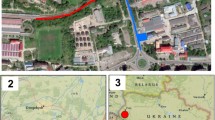Abstract
Magnetic measurements of soil and tree bark adjacent to a busy highway revealed a significant variation in the concentration of magnetic particles with distance from the highway. Further more, forest-facing tree-bark contains significantly more magnetic particles than road-facing tree-bark. Magnetic particles were detected both on the bark of the maple trees and in the first centimeter of the soil cover (O/A horizon). Stability of saturation isothermal magnetization (SIRM) and hysteresis parameters of the soil indicates the presence of single domain (SD/PSD) magnetic carriers. Measurements of the tree bark hysteresis parameters and SIRM detect a significant lower coercivity component that we interpret to be an indication of more abundant pseudo-single domain (PSD) type magnetic grains. Magnetic measurements around the perimeters of eight tree trunks reveal magnetic carriers whose distribution is antipodal to the source direction (highway). We interpret our observation by adopting an air circulation model, where suspended PSD/SD particles are carried in the air stream. The air stream from the heavy traffic lowers the amount of moisture on the tree trunk surfaces facing the highway and thus reduces an adhesive potential on this side. Therefore, more particles can stay on the moist side of the trunk protected from the direct airflow.
Similar content being viewed by others
References
Assuncao A.G.L., Martins P.D., De Folter S., Vooijs R., Schat H. and Aarts M.G.M., 2001. Elevated expression of metal transporter genes in three accessions of the metal hyperaccumulator Thlaspi caerulescens. Plant Cell and Environment, 24, 217-226.
Badar U., Ahmed N., Beswick A.J., Pattanapipitpaisal P. and Macaskie L.E., 2000. Reduction of chromate by microorganisms isolated from metal contaminated sites of Karachi, Pakistan. Biotechnology Letters, 22, 829-836.
Day R., Fuller M. and Schmidt V.A., 1977. Hysteresis properties of titanomagnetites: grain-size and compositional dependence. Phys. Earth Planet. Inter., 13, 260-266.
Ghaderian Y.S.M., Lyon A.J.E. and Baker A.J.M., 2000. Seedling mortality of metal hyperaccumulator plants resulting from damping off by Pythium spp. New Phytologist, 146, 219-224.
Han F.X., Kingery W.L., Selim H.M. and Gerard P.D., 2000. Accumulation of heavy metals in a long-term poultry waste-amended soil. Soil Science, 165, 260-268.
Heller F., Strzyszcz Z. and Magiera T., 1998. Magnetic record of industrial pollution in forest soils of Upper Silesia, Poland. J. Geophys. Res.-Solid Earth, 103, 17767-17774.
Kapička A., Jordanova N., Petrovský E. and Ustjak S., 2000. Magnetic stability of power-plant fly ash in different soil solutions. Phys. Chem. Earth A -Solid Earth and Geodesy, 25, 431-436.
Kapička A., Petrovský E., Jordanova N. and Podrázský V., 2001. Magnetic parameters of forest top soils in Krkonose Mountains, Czech Republic. Phys. Chem. Earth A -Solid Earth and Geodesy, 26, 917-922.
Kapička A., Petrovský E., Ustjak S. and Macháčková K., 1999. Proxy mapping of fly-ash pollution of soils around a coal- burning power plant: a case study in the Czech Republic. J. Geochem. Explor., 66, 291-297.
Kletetschka G., 1994. A Study of the Origin and Nature of Secondary Iron Oxides in Chinese Loess. Master thesis. University of Minnesota, Minneapolis.
Kletetschka G., Wasilewski P.J. and Taylor P.T., 2000. Hematite vs. magnetite as the signature for planetary magnetic anomalies? Phys. Earth Planet. Inter., 119, 259-267.
Lecoanet H., Léveque F. and Arnbrosi J.P., 2001. Magnetic properties of salt-marsh soils contaminated by iron industry emissions (southeast France). J. Appl. Geophys., 48, 7-81.
Magiera T. and Strzyszcz Z., 2000. Ferrimagnetic minerals of anthropogenic origin in soils of some Polish national parks. Water Air Soil Pollut., 124, 37-48.
Schmidt M.W.I., Knicker H., Hatcher P.G. and Kogel-Knabner I., 2000. Airborne contamination of forest soils by carbonaceous particles from industrial coal processing. J. Environ. Quality, 29, 768-777.
Silver S. and Phung L.T., 1996. Bacterial heavy metal resistance: New surprises. Annual Review of Microbiology, 50, 753-789.
Strzyszcz Z., 1999. Heavy metal contamination in mountain soils of Poland as a result of anthropogenic pressure. Izvestiya Akademii Nauk Seriya Biologicheskaya, 6, 722-735.
Author information
Authors and Affiliations
Rights and permissions
About this article
Cite this article
Kletetschka, G., Žila, V. & Wasilewski, P.J. Magnetic Anomalies on the Tree Trunks. Studia Geophysica et Geodaetica 47, 371–379 (2003). https://doi.org/10.1023/A:1023779826177
Published:
Issue Date:
DOI: https://doi.org/10.1023/A:1023779826177




